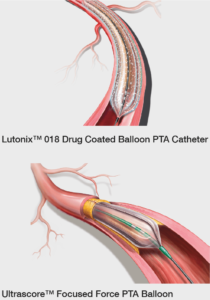This advertorial, sponsored by BD, is intended for healthcare professionals in Europe only.

“Improving vessel compliance with focused force longitudinal plaque fracture seems to be a promising strategy instead of standard percutaneous transluminal angioplasty [PTA],” states interventional angiologist Michael Lichtenberg (Arnsberg Vascular Center, Arnsberg, Germany), detailing that the technique avoids “significant vessel damage”. In this case report for Vascular News, Lichtenberg evidences this claim, outlining a case involving the recanalisation of a long superficial femoral artery (SFA) occlusion involving lesion preparation with an Ultrascore™ Focused Force PTA Balloon (BD) followed by angioplasty using a Lutonix™ 018 Drug Coated Balloon PTA Catheter (BD).
An 80-year-old man with severe claudication of the right leg was admitted to our vascular centre. Cardiac risk factors included poorly-controlled diabetes, hyperlipoproteinaemia, and smoking. On duplex ultrasound, a long occlusion of the right SFA from the origin to the popliteal artery was diagnosed (Figures 1 and 2). Ankle brachial index (ABI) on the right side was 0.6. No wounds were present on the right extremity.
 Subsequent diagnostic angiography confirmed the long SFA occlusion with diminished contrast flow below the knee and into the foot. For recanalisation of the long SFA occlusion, a crossover approach from the left groin was performed using the new Halo One™ Thin-Walled Guiding Sheath (BD) 70cm, 5 French. This sheath provides a 1 French wall thickness, which reduces the size of the arteriotomy compared to standard sheaths of the same French size without sacrificing inner diameter. The flush occlusion of the SFA (Figure 3) was penetrated with a 0.018” Glidewire Advantage (Terumo Interventional Systems). It was easy to achieve distal re-entry into the true lumen. Next, a two-minute lesion preparation was performed with an Ultrascore™ Focused Force PTA Balloon 5x150mm 5 French with repetitive inflation to 8atm over the whole length of the target lesion. This scoring balloon is designed to longitudinally fracture plaque at a lower inflation pressure. Compared to a standard balloon angioplasty, the Ultrascore™ Focused Force PTA Balloon provides approximately 24 times more force where the wire contracts the lesion. This lesion preparation was then followed by two-minute drug-coated balloon (DCB) angioplasty (Lutonix™ 018 Drug Coated Balloon PTA Catheter 5x220mm and 5x120mm; Figure 4). Subsequent angiographic analysis ruled out a persistent dissection or significant recoil.
Subsequent diagnostic angiography confirmed the long SFA occlusion with diminished contrast flow below the knee and into the foot. For recanalisation of the long SFA occlusion, a crossover approach from the left groin was performed using the new Halo One™ Thin-Walled Guiding Sheath (BD) 70cm, 5 French. This sheath provides a 1 French wall thickness, which reduces the size of the arteriotomy compared to standard sheaths of the same French size without sacrificing inner diameter. The flush occlusion of the SFA (Figure 3) was penetrated with a 0.018” Glidewire Advantage (Terumo Interventional Systems). It was easy to achieve distal re-entry into the true lumen. Next, a two-minute lesion preparation was performed with an Ultrascore™ Focused Force PTA Balloon 5x150mm 5 French with repetitive inflation to 8atm over the whole length of the target lesion. This scoring balloon is designed to longitudinally fracture plaque at a lower inflation pressure. Compared to a standard balloon angioplasty, the Ultrascore™ Focused Force PTA Balloon provides approximately 24 times more force where the wire contracts the lesion. This lesion preparation was then followed by two-minute drug-coated balloon (DCB) angioplasty (Lutonix™ 018 Drug Coated Balloon PTA Catheter 5x220mm and 5x120mm; Figure 4). Subsequent angiographic analysis ruled out a persistent dissection or significant recoil.
After revascularisation, a brisk flow was seen within the whole length of the target lesion, as was a straight flow into the foot (Figures 5 and 6). Follow-up examination of the patient the next day showed an ABI of 0.95 on the right side and a significant improvement in pain-free walking distance with no pain in the target limb during a treadmill test after 500m.
Many options for endovascular revascularisation therapy exist today. Most therapeutic approaches involve PTA as the primary therapy, which consists of adventitial stretching, medial necrosis, and controlled dissection or plaque fracture. Acute vessel damage is frequently seen in non-compliant calcified atherosclerotic vessels and may range from simple plaque rupture to severe flow-limiting dissection, or even local perforations. Dissections can induce pathologic haemodynamic defects, and have been implicated as a contributing factor in acute procedural complications as well as restenosis at the target lesion site. Therefore, improving vessel compliance with focused force longitudinal plaque fracture seems to be a promising strategy instead of standard PTA to avoid significant vessel damage, which may lead to long stent implantation. Reassuringly, the results of the SWEDEPAD interim analysis adds further important safety data on drug-coated devices when used to treat femoropopliteal disease.
Case images

 © 2020 BD. BD, the BD logo, Bard, Halo One, Ultrascore and Lutonix are the property of Becton, Dickinson and Company. All other trademarks are property of their respective owners. Illustrations by Mike Austin. Copyright © 2020. All Rights Reserved.
© 2020 BD. BD, the BD logo, Bard, Halo One, Ultrascore and Lutonix are the property of Becton, Dickinson and Company. All other trademarks are property of their respective owners. Illustrations by Mike Austin. Copyright © 2020. All Rights Reserved.










